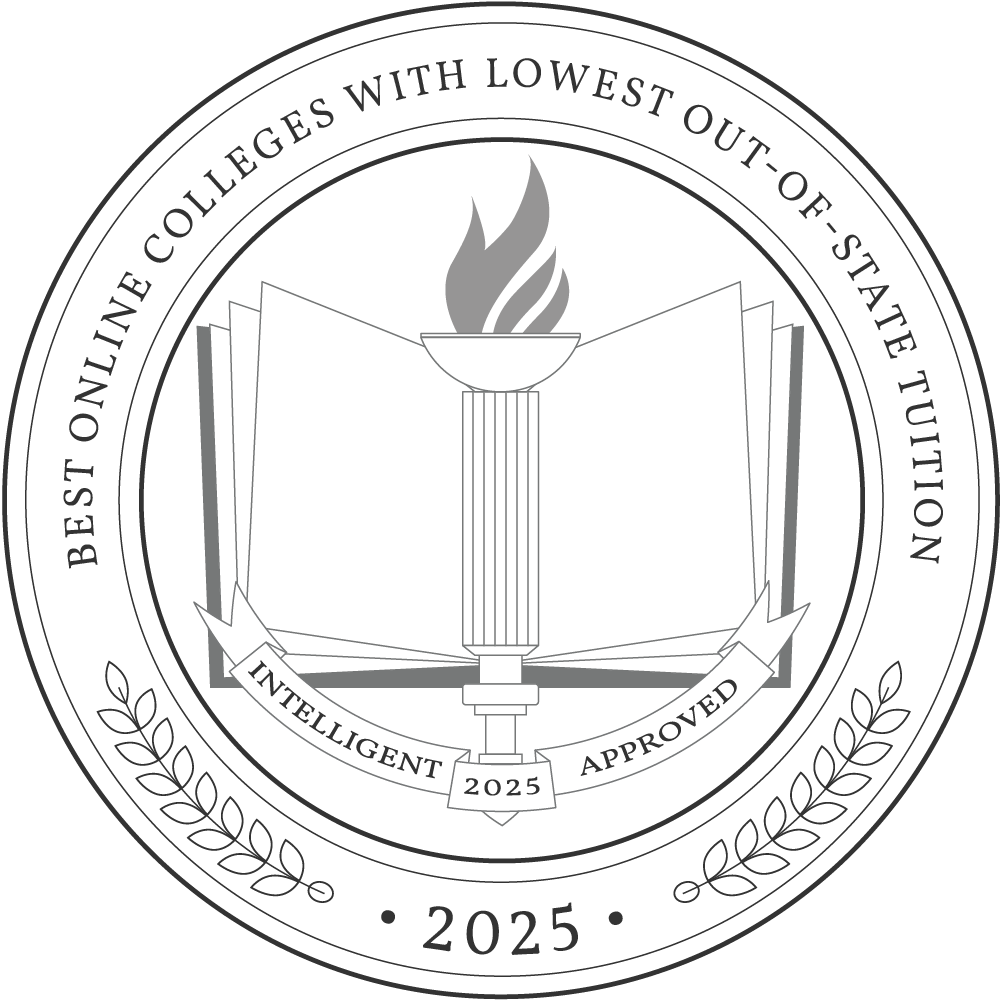Public universities offer some of the strongest post-secondary degree programs in the U.S., making them an attractive option for both in-state and out-of-state students. However, because of their funding model, public colleges typically charge students different tuition rates based on residency, with in-state students getting discounted tuition rates.
However, that doesn’t mean that out-of-state students are out of luck when finding an online college with affordable tuition. Intelligent.com compiled this list of the best online colleges with the lowest out-of-state tuition and information on how to find an online degree program that fits your budget.
The Top 50 Online Colleges with Low Out-of-State Tuition

Discover More Options
How we rank schools
This list features the best online college programs with low out-of-state tuition in the country. Each school featured is a nonprofit, accredited institution — either public or private — with a high standard of academic quality for post-secondary institutions. The programs on our list have been accredited by reputable organizations, such as the Higher Learning Commission and New England Commission of Higher Education, that assess the objectives, quality, and overall effectiveness of colleges and universities.
We evaluated each school’s program on tuition costs, admission, retention and graduation rates, faculty, and reputation as well as the student resources provided for online students. Then we calculated the Intelligent Score on a scale of 0 to 100. Read more about our ranking methodology.
Next, we compared this comprehensive list of online college programs with low out-of-state tuition to a list of aggregated college rankings from reputable publications like the U.S. News & World Report, among others, to simplify a student’s college search. We pored through these rankings so students don’t have to.
What You Should Know About Online Colleges with Low Out-of-State Tuition
In the U.S., post-secondary institutions are classified as public or private, based on how they are funded. Private colleges are funded exclusively through tuition revenue, donations, endowments, and other revenue streams. They do not receive any funding from federal or state governments and charge all students the same tuition rate, regardless of where their permanent residence is.
Meanwhile, public universities receive state and federal government money to fund their operations. Because state tax dollars go towards funding public institutions, students who attend a public college in their home state receive discounted tuition. Students who attend a public college in a different state than their primary residence, either in-person or online, are typically charged the full tuition amount.
Out-of-state tuition rates at public institutions vary widely, with some being comparable to tuition at private schools. However, as online degree programs have become more widespread, some public universities have started charging online students in-state tuition rates. Many states within certain regions of the U.S., like New England or the Midwest, have developed reciprocity or student exchange agreements to allow students to attend schools within the region at in-state tuition prices. When considering attending a public college as an out-of-state online student, consult with the institution’s financial aid office to determine if you are eligible for an in-state tuition rate.
When enrolling in an online degree program in a different state, it’s also essential to ensure that the degree will be recognized for any required professional credentials or licenses you may need, such as a nursing or teaching license. Additionally, students should ensure that the out-of-state school they’re attending remotely is authorized to grant degrees in the student’s home state. The National Council for State Authorization Reciprocity Agreements (NC-SARA) has further information about reciprocity agreements between colleges and universities in different states.
Pros and cons of attending an online college with low out-of-state tuition
Pros
-
Accessibility
Public universities tend to offer a wide variety of degree programs and areas of study. Considering out-of-state options may make it easier for students to find a program that aligns with their interests and career goals, especially if their in-state public schools don’t offer their desired major. Enrolling online means students don’t have to relocate to attend their desired programs.
-
Affordability
Depending on the state where a student lives and the state in which their school is located, out-of-state tuition may be less than in-state tuition. For example, the average annual in-state tuition for public colleges in Vermont is $17,600, while the average annual out-of-state tuition in South Dakota is $13,000, according to the Education Data Initiative. Therefore, a Vermont resident would likely pay less if they enrolled in a degree program at a public university in South Dakota.
-
Flexibility
Attending an online program gives students more flexible schedules and living arrangements. Online programs, especially those delivered asynchronously, allow students to access lessons and assignments whenever is most convenient, making it easier to balance schoolwork with full-time jobs, families, and other responsibilities. Additionally, students can save money by living in an area with a lower cost of living than where their school is located. For out-of-state students, this can help make the difference if tuition is more expensive at an out-of-state school.
Cons
-
Tuition may still be more expensive than at an in-state institution
Just because a college has a low out-of-state tuition rate doesn’t mean tuition will be more affordable than it would be at an in-state school. When selecting an online degree program, students should research all in-state and out-of-state options, and determine whether the additional charges they may pay for an out-of-state program are worth it.
-
Admission may be more selective
Because part of the mission of public universities is to provide education to residents within their state, they prioritize admitting students from within that state. Therefore, admissions may be more selective for out-of-state students, as there are fewer places in the incoming class for non-residents.
How to Choose the Online College with Lowest Out-of-State Tuition That’s Right For You
Clarify your education and career goals
The first step in selecting the right online college with low out-of-state tuition is clarifying your educational and career goals. This will help you narrow your focus to in-state and out-of-state schools that offer degree or certificate programs that align with your interests and needs.
If you need help determining what career field or area of study interests you, taking a career assessment or personality test can be helpful in giving you options that play to your aptitudes.
Now is also a smart time to determine your logistical needs. For example, do you want an online program that delivers courses asynchronously or synchronously? Are you planning to attend classes part-time or full-time? What is your overall budget and how much financial aid will you need?
Research schools and programs
Once you have established parameters for what you’re seeking in an online program, begin researching schools that meet your criteria. Most schools publish essential information, including in-state and out-of-state tuition and fees, financial aid opportunities, program curriculums and faculty bios on their website. Students can also contact the school’s admissions office to speak to an admissions counselor, or participate in virtual open houses or information sessions to get a more in-depth look at a school.
During the research process, students should confirm that the schools they’re considering are accredited by a recognized regional accrediting agency. Accreditation ensures that the institution meets rigorous standards for high-quality education and awards legitimate recognized degrees. Only students enrolled at accredited schools can be considered for federal financial aid and a school’s accreditation status can also affect future employment and educational opportunities.
Other helpful questions to ask during the research process include:
- Are classes offered synchronously or asynchronously?
- How do online students interact with classmates and faculty?
- Who are the faculty and what are their qualifications?
- Are there any experiential learning components, like internships?
- What networking opportunities are available to online students?
- What support services does the school provide to online students?
Review admissions and eligibility requirements
Also when researching schools and programs, carefully review their admissions processes and check with an admissions counselor if you have any questions. Application procedures and requirements vary among schools, so it might be helpful to create a spreadsheet or checklist to keep track of submissions, especially if you’re applying to multiple schools.
A standard application for an undergraduate degree consists of:
- Completed application and required fees
- Official high school transcript showing proof of graduation or a GED
- Letters of recommendation
- An essay or personal statement
- A resume
- SAT or ACT scores (if required)
Applications for graduate programs are similar, although there may be more eligibility criteria, like a minimum undergraduate GPA or specific undergraduate degree. Programs may also require that students submit GRE or GMAT scores.
Determine how you’ll pay for your degree
If you haven’t already, gather information about tuition rates, fees, and available financial aid options at the school’s you’re considering. This information is typically available through a college’s website, but you can also speak to a financial aid counselor if you have questions.
Students who want to be considered for need-based financial aid, such as federal student loans, scholarships, grants, and work-study, should complete the Free Application for Federal Student Aid (FAFSA). Institutions use this information to determine eligibility for this kind of financial aid. Many schools and external organizations also offer merit-based aid for high-achieving students, including scholarships, grants, and fellowships. Out-of-state students should clarify what types of financial aid are available to them, as public colleges may have more options available for in-state students.
If you’re working while attending an online college, find out if your employer offers employer tuition assistance benefits. Veterans or active-duty military members should explore tuition discounts and GI Bill benefits. It’s also common for schools to offer payment plans so students can pay tuition in installments.

